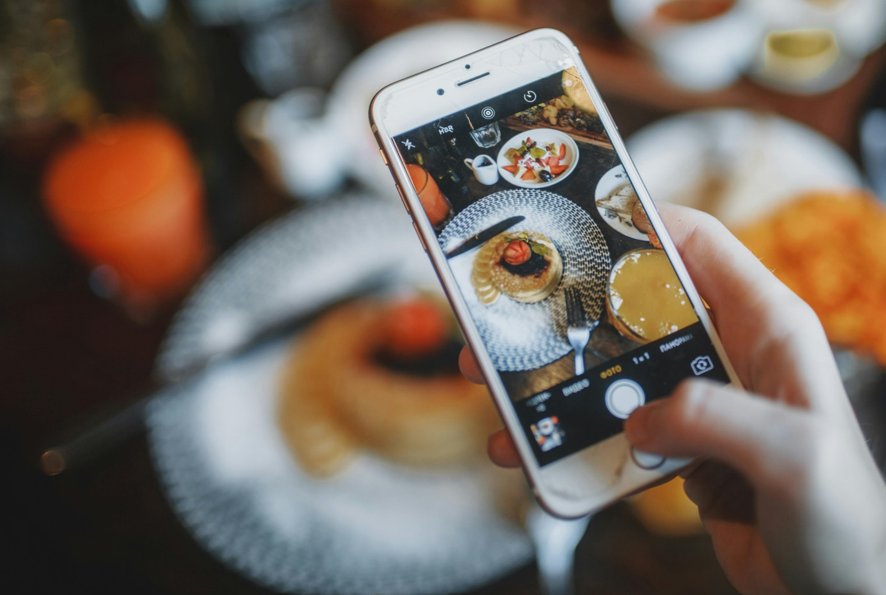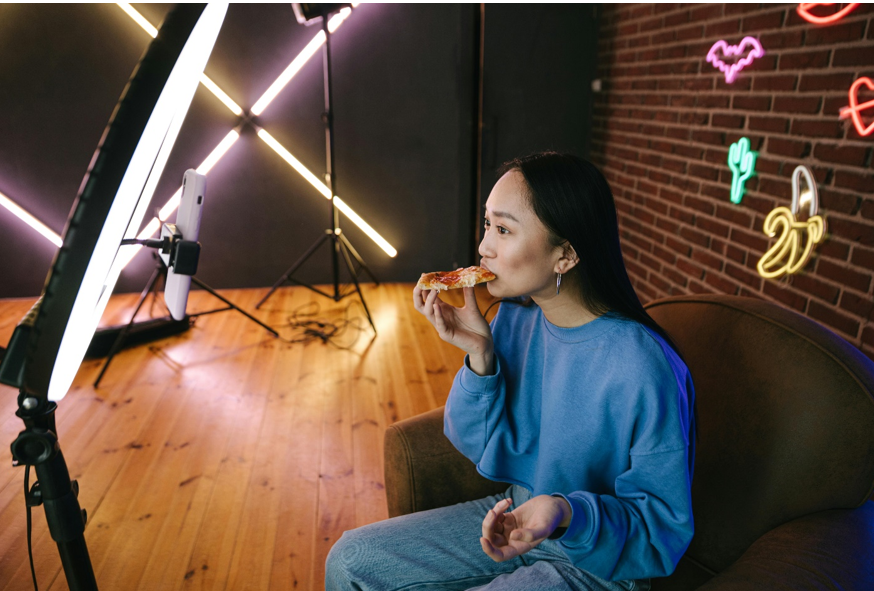Behind the Screens – The Unseen Marketing
What do we know about what youth see on their mobile phone? Our mobile phones and social media are highly private and mostly for good reasons. It is our own alternative and digital world. Youth spend hours and hours daily on their mobile phones exploring this world. Unfortunately, there are some cons of this privacy. Our data is not private to commercial actors, and our time and following of different profiles on social media is a part of a huge digital economy. As we do not see what other people see on social media, it is not that easy to regulate unhealthy content, such as the marketing of unhealthy foods and drinks. Furthermore, children often use consumer goods to belong in a group (Pugh, 2011). This phenomenon was demonstrated last summer when popular YouTubers Logan Paul and KSI promoted the sports drink PRIME Hydration in Norway. Thousands of children turned up to the event and the sports drink was flying of the shelves for a long period of time (Eriksen et al., 2023). The sports drink was primarily promoted in social media.

Food Environments
Lately, the term Food Environments has been coming up as a relevant subject. From the Public Health Institute of Norway comes the following definition: “Food environments are the physical, economic, political, and sociocultural contexts in which people interact with the food system when making choices about acquiring, preparing, and consuming food. This includes both physical and digital/virtual environments.” (Uldahl & Torheim, 2023). This also means that the foods and drinks we see on social media are a part of our Food Environment. Studies do indicate that advertising for unhealthy food and drink can influence children and adolescents’ choices, as well as change their attitudes and preferences towards different foods and drinks (Buchanan et al., 2018; Cairns et al., 2013; Coates et al., 2019; Harris et al., 2021; Kucharczuk et al., 2022; Lykke & Selberg, 2022; Mc Carthy et al., 2022; Sadeghirad et al., 2016; Smith et al., 2019).

Marketing for unhealthy foods and drinks in Norway
The Norwegian government is now planning to implement a new legislation to regulate marketing towards children and youth under the age of 18 (Innst. 398 S (2022-2023), 2023). However, our understanding of the amount of marketing of unhealthy foods and drinks on social media remains limited because the research methods are still insufficient. Social media platforms are rapidly changing alongside the forms of marketing. This makes it hard to follow the evolution of marketing on social media based on the existing methods. Formerly, my colleague Alexander Schjøll and I explored how much marketing a selection of influencers posted on social media over a period of three months (Tangen & Schjøll, 2023). Our findings revealed that nearly a quarter (24%) of all posts were marketing. The most frequently marketed categories were food and drinks, primarily sports and energy drinks, followed by clothing and accessories. Still, these results can just indicate the current situation, not generalize anything. Other Norwegian studies have shown different types of marketing to be more common (Retriever, 2022; Steinnes & Haugrønning, 2020).

In our study, even though we looked at popular influencers, we do not know what children and adolescents see on their own phones. We could not look into the ads, both traditional and personalized, that are displayed to each person based on their algorithms. Similar studies to ours have been done, but to this author’s knowledge, no other studies have been able to measure marketing in children’s and adolescent’s mobiles in a satisfying and precise way.

Making the unseen marketing visible
Therefore, we are currently working on a project to monitor marketing on social media in cooperation with WHO and The Norwegian Institute of Public Health. Adolescents aged 13-18 are going to download an application developed by WHO. This application will monitor and capture screenshots from Facebook, Snapchat, Instagram, TikTok, and YouTube when our respondents use it. In this way we can capture and count the real exposure of marketing adolescents witness on social media. SIFO researchers Steinnes & Haugrønning (2020) conducted a study with a former version of the application, where the initial version processed the content of photos and returned text-based data. Their study provided promising results for further development and use of this method. Now, the application is further developed to take screenshots, sort out sensitive images by using AI and includes an analyzing tool who tags brands and commercials. Our continuation of Steinnes & Haugrønning’s (2020) method and a newer version of the application will provide us with new insights into unseen marketing on social media and youths digital food environments.

Bio
Hanna Seglem Tangen is a research assistant at Consumption Research Norway (SIFO), belonging in the research group Sustainable Textile and Food Consumption. Hanna’s research interests include sustainable food consumption, public health, advertising and marketing, politics, policy, and evaluation. She applies with both qualitative and quantitative methods in her work.
References
Buchanan, L., Yeatman, H., Kelly, B., & Kariippanon, K. (2018). A thematic content analysis of how marketers promote energy drinks on digital platforms to young Australians. Australian and New Zealand Journal of Public Health, 42(6), 530–531. https://doi.org/10.1111/1753-6405.12840
Cairns, G., Angus, K., Hastings, G., & Caraher, M. (2013). Systematic reviews of the evidence on the nature, extent and effects of food marketing to children. A retrospective summary. Appetite, 62, 209–215. https://doi.org/10.1016/j.appet.2012.04.017
Coates, A. E., Hardman, C. A., Halford, J. C. G., Christiansen, P., & Boyland, E. J. (2019). Social Media Influencer Marketing and Children’s Food Intake: A Randomized Trial. Pediatrics, 143(4), e20182554. https://doi.org/10.1542/peds.2018-2554
Eriksen, D., Sørnes, A. J., Haugen, K., & Klokkerud Odden, F. (2023, June 27). Tusenvis av fans møtte Youtube-stjerner i Oslo. NRK. https://www.nrk.no/kultur/tusenvis-av-fans-motte-youtube-stjerner-i-oslo-1.16462419
Harris, J. L., Yokum, S., & Fleming-Milici, F. (2021). Hooked on Junk: Emerging Evidence on How Food Marketing Affects Adolescents’ Diets and Long-Term Health. Current Addiction Reports, 8(1), 19–27. https://doi.org/10.1007/s40429-020-00346-4
Innst. 398 S (2022-2023). (2023). Innstilling fra helse- og omsorgskomiteen om Folkehelsemeldinga – Nasjonal strategi for utjamning av sosiale helseforskjellar. Helse- og omsorgskomiteen. https://www.stortinget.no/no/Saker-og-publikasjoner/Publikasjoner/Innstillinger/Stortinget/2022-2023/inns-202223-398s/?m=3&c=False
Kucharczuk, A. J., Oliver, T. L., & Dowdell, E. B. (2022). Social media’s influence on adolescents′ food choices: A mixed studies systematic literature review. Appetite, 168, 105765. https://doi.org/10.1016/j.appet.2021.105765
Lykke, M. B., & Selberg, N. (2022). Usund digital markedsføring. Effekten af digital markedsføring af fødevarer med et højt indhold af fedt, salt og sukker på børn og unges fødevarevalg – en kortlægning af den videnskabelige evidens. Hjerteforeningen.
Mc Carthy, C. M., de Vries, R., & Mackenback, J. D. (2022). The influence of unhealthy food and beverage marketing through social media and advergaming on diet‐related outcomes in children—A systematic review. Obesity Reviews, 23(6), https://doi.org/10.1111/obr.13441.
Pugh, A. J. (2011). Distinction, boundaries or bridges?: Children, inequality and the uses of consumer culture. Poetics, 39(1), 1–18. https://doi.org/10.1016/j.poetic.2010.10.002
Retriever. (2022). Hva kommuniserer norske og utenlandske influensere til norske ungdommer på sosiale medier? Medietilsynet. https://www.medietilsynet.no/globalassets/publikasjoner/barn-og-medier-undersokelser/2022/influenseranalyse.pdf
Sadeghirad, B., Duhaney, T., Motaghipisheh, S., Campbell, N. R. C., & Johnston, B. C. (2016). Influence of unhealthy food and beverage marketing on children’s dietary intake and preference: A systematic review and meta-analysis of randomized trials. Obesity Reviews, 17(10), 945–959. https://doi.org/10.1111/obr.12445
Smith, R., Kelly, B., Yeatman, H., & Boyland, E. (2019). Food Marketing Influences Children’s Attitudes, Preferences and Consumption: A Systematic Critical Review. Nutrients, 11(4), Article 4. https://doi.org/10.3390/nu11040875
Steinnes, K. K., & Haugrønning, V. (2020). Mapping the landscape of digital food marketing: Investigating exposure of digital food and drink advertisements to Norwegian children and adolescents. Consumption Research Norway (SIFO), OsloMet. https://oda.oslomet.no/oda-xmlui/handle/20.500.12199/6510
Tangen, H. S., & Schjøll, A. (2023). Eksponering for markedsføring av usunn mat og drikke. Reklame rettet mot barn og unge i sosiale medier. In 55 (Report SIFO-rapport;14-2023). Forbruksforskningsinstituttet SIFO, OsloMet. https://oda.oslomet.no/oda-xmlui/handle/11250/3107927
Uldahl, M., & Torheim, L.-E. (2023). Metoder og indikatorer for kartlegging og overvåkning av matomgivelser i Norge. Folkehelseinstituttet. https://www.fhi.no/publ/2023/matomgivelser/